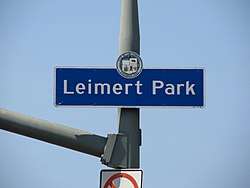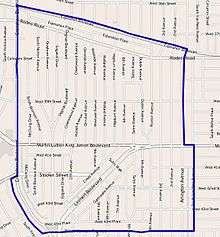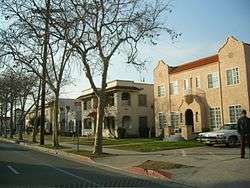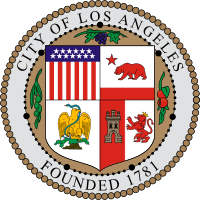Leimert Park, Los Angeles
| Leimert Park | |
|---|---|
| Neighborhood of Los Angeles | |
 Leimert Park signage located on Leimert Boulevard immediately north of Vernon Avenue | |
 Leimert Park Location within South Los Angeles | |
| Coordinates: 34°00′45″N 118°19′34″W / 34.0125°N 118.3261°WCoordinates: 34°00′45″N 118°19′34″W / 34.0125°N 118.3261°W | |
| Country |
|
| State |
|
| County |
|
| City | Los Angeles |
| Time zone | Pacific |
| Zip Code | 90008 |
| Area code(s) | 323 |
Leimert Park is a residential neighborhood in the South Los Angeles region, in the city of Los Angeles, California. It was developed in the 1920s as a master-planned community featuring Spanish Colonial Revival homes and tree-lined streets. It has become the center of both historical and contemporary African-American art, music, and culture in Los Angeles. The neighborhood is associated with the park of the same name.[1]
Geography
Location

Jefferson Park flanks Leimert Park to the north, the Exposition Park neighborhood and Vermont Square are to the east, Hyde Park to the south and View Park-Windsor Hills and Baldwin Hills/Crenshaw to the west. Leimert Park angles to the West Adams district on the northwest.[2]
Leimert Park is bounded by Exposition Boulevard on the north, South Van Ness Avenue and Arlington Avenue on the east, West Vernon Avenue on the south, and Victoria Avenue and Crenshaw Boulevard on the west.[3][4]
History
Leimert Park is named for its developer, Walter H. Leimert, who began the subdivision business center project in 1928. He had the master plan designed by the Olmsted Brothers landscape architecture firm managed by the sons of Frederick Law Olmsted, the landscape designer known for Central Park in New York City and other major projects.[5] Leimert Park was one of the first comprehensively planned communities in Southern California to be designed for upper and middle-income families. It was considered a model of urban planning for its time: automobile traffic near schools and churches was minimized, utility wires were buried or hidden from view in alleys, and densely planted trees lined its streets. Walter Leimert envisioned a self-sufficient commercial district community, with a town square, movie theater, transportation, and retail shopping. Leimert Park was considered a desirable community, and one of the first to have a Home Owners' Association (HOA).

The Mediterranean Revival Style Leimert Park Theater (now renamed the Vision Theatre), is located at the south end of Leimert Park Village at 3341 West Forty-Third Place and Degnan Avenue. It was designed in 1931 by the architectural firm Morgan, Walls & Clements, and opened as a movie theatre on April 21, 1932. It is designated as a Los Angeles Historic-Cultural Monument.
Initially settled primarily by European Americans, after World War II, some moved to other communities. Japanese Americans integrated Leimert Park in this period.
The Crenshaw Square Shopping Centre was inspired and designed in the style of Japanese architecture. Tak's Coffee still operates on Crenshaw Boulevard. Elderly Japanese-American residents still live in Leimert Park, and some of the Japanese gardens still exist.[6] African Americans began to integrate Leimert Park in the 1950s. Leimert and the neighboring Crenshaw District eventually became one of the largest black middle class neighborhoods in the United States.
Present day
Culture
Leimert Park has been referred to as the center of a contemporary African-American arts scene in Los Angeles. It has been described as "the black Greenwich Village."[5]
Entertainment
Leimert Park has blues and jazz night clubs, theaters for musicals, dramatic performances, award ceremonies, comedy specials, and poetry readings, and venues for hip hop. Project Blowed is the longest-running hip hop open mic in the world, started in 1994 by Aceyalone and friends. It is hosted by Kaos Network, and held every Thursday night at 43rd Place and Leimert Boulevard.[7]
Leimert Plaza Park
Leimert Plaza Park is at the district's center park, adjoined by retail shops and the historic Vision Theatre.[5] It is a popular place for live performances and neighborhood gatherings.[8] The cascading fountain has been given landmark status.
Tavis Smiley, host and producer of National Public Radio (NPR) and the former nationally syndicated talk show Tavis Smiley on PBS, has production studios called The Smiley Group, Inc located within the Leimert Park neighborhood.[9]
The Lucy Florence Coffee House and Cultural Center was established in Leimert Park in early 1996; it hosted an array of talent, art, restaurant and music. Lucy Florence was located at 3351 West 43rd Street and Degnan Avenue. It was owned by Richard and Ron Harris, also known as the Aswirl Twins on America's Next Top Model. The coffee house was named after their mother Lucy Florence on her 75th birthday; it was then located in the Hollywood neighborhood. In January 2012, Lucy Florence coffee shop closed in Leimert Park.
Another famous jazz venue is 5th Street Dick's Coffee and Jazz Emporium, founded by Richard Fulton in 1992. Fulton died on March 18, 2000. It continues to be a mainstay for jazz music lovers, professional chess players, poets and famous comedians.
Transportation
Crenshaw/LAX Line
Construction is underway on the Leimert Park station, on the Los Angeles Metro light rail Crenshaw/LAX Line. It will be located near the intersection of Crenshaw Boulevard and Vernon Avenue.[1] Nearby Leimert Plaza Park is planned to be part of a new walkable corridor with a direct entrance into the station. It will also have new parking structures. A section of 43rd Place will be closed to car traffic and converted to a public plaza. Some businesses may be required to have a front entrance for people strolling down the street.[1][10]
Real estate
In 2013 and 2014, resurgent home prices in South Los Angeles spurred much interest among many young professionals into moving into Leimert Park and among other areas within the region. Observers took note with mixed feelings: fears of gentrification and hope for increased business investment.[11]
Population
A total of 11,782 people lived in Leimert Park according to the 2000 U.S. census— counted 9,880 residents in the 1.19 square-mile neighborhood, about the same as the population density in the city as a whole. The median age was 38, considered old as opposed to the rest of the city. The percentage of residents aged 65 and above was among the county's highest.[4]
Within the neighborhood, African Americans made up 79.6% of the population, with Latinos at 11.4%, Asian 4.9%, White 1.5%, and Other 3.2%. El Salvador and Mexico were the most common places of birth for the 10.7% of the residents who were born abroad. This is a low percentage of foreign-born when compared with the overall city or LA county.[4]
The median household income in 2008 dollars was $45,865, considered average for the city but low for the county. The percentage of households earning $20,000 or less was high, compared to the county at large. The average household size of 2.2 people was low for both the city and the county. Renters occupied 54.1% of the housing units, and homeowners occupied the rest.[4]
In 2000 there were 23 families headed by single parents, or 8.7%, a rate that was low for the city and the county. There were 990 veterans, or 11.1% of the population, considered high when compared with the city overall. The percentage of veterans who served in the Vietnam War was among the county's highest.[4]
- These are the ten neighborhoods in Los Angeles County with the largest percentage of black residents:[12]
- View Park-Windsor Hills, California, 86.5%
- Gramercy Park, Los Angeles, 86.4%
- Leimert Park, Los Angeles, 79.6%
- Manchester Square, Los Angeles, 78.6%
- Baldwin Hills/Crenshaw, Los Angeles, 71.3%
- Ladera Heights, California, 71%
- Hyde Park, Los Angeles, 66%
- Chesterfield Square, Los Angeles, 58.6%
- West Rancho Dominguez, California, 57.6%
- Westmont, California, 57.5%
Education
Leimert Park residents aged 25 and older holding a four-year degree amounted to 55.9% of the population in 2000, about average within the city and the county. A high percentage of residents aged 25 and older had a college education.[4]
Leimert Park is served by Los Angeles Unified School District. Within Leimert Park are the following schools:[3][13]
- C.A.T.C.H High School, charter high school, 4120 11th Avenue
- Audubon Middle School, 4120 11th Avenue, LAUSD
- Tom Bradley Global Awareness Magnet, LAUSD alternative, 3875 Dublin Avenue
- Transfiguration Elementary, 4020 Roxton Avenue (private)
- Creative Learning Center Elementary, 1726 West Martin Luther King Jr. Boulevard (private)
- New Heights Charter Elementary, 2202 West Martin Luther King Jr. Boulevard (LAUSD)
- Forty-Second Street Elementary, 4231 Fourth Avenue (LAUSD)
Other schools
- Libertas College Preparatory (on the Tom Bradley campus), 2875 Dublin Avenue (charter)
Recreation and parks
- Leimert Plaza Park is located on 4395 Leimert Boulevard, Los Angeles, California, unstaffed, with picnic tables, park bathrooms, benches, decorative water fountain and the under construction Leimert Park station.[14]
- Pocket Park at Degnan Boulevard and Norton Avenue, unnamed[3]
- People St Plaza, between the Leimert Plaza Park and the Vision Theater on 43rd Place.[15]
Notable residents
- Tom Bradley (1917-1998), former Los Angeles Mayor [16]
- Ray Charles (1930-2004), singer[17]
- Ella Fitzgerald (1917-1996), singer[17]
- Mark Bradford, artist known for grid-like abstract paintings combining collage with paints.[18]
- Carl C. Rasmussen (1901–1952), Los Angeles City Council member[19][20]
- Dom Kennedy, rapper[21]
- Busdriver, hip-hop artist[22]
See also
References
- 1 2 3 Jennings, Angel (February 10, 2014) "Station identification" Los Angeles Times
- ↑ "South L.A.," Mapping L.A., Los Angeles Times
- 1 2 3 The Thomas Guide, 2006, page 633
- 1 2 3 4 5 6 "Leimert Park," Mapping L.A., Los Angeles Times
- 1 2 3 Lee, Gary (March 19, 2006). "Los Angeles's Black Pride". Washington Post. Retrieved 2 November 2017.
- ↑ "Growing Up Japanese American in Crenshaw and Leimert Park". 30 January 2014.
- ↑ Vigeland, Tess (March 28, 2013). "Neighborhoods: Leimert Park's important place in LA's cultural history )3". Take Two. KPCC. Retrieved 1 November 2017.
- ↑ Lee, Gary (March 19, 2006) "Los Angeles Black Pride: Taking in the Retro Vibe of Leimert Park", Washington Post
- ↑ "Tavis Talks". tavistalks.com. Archived from the original on 2017-05-28. Retrieved 2017-06-05.
- ↑ Reyes, Emily Alpert and Jennings, Angel (December 8, 2014) "Military retailer is Leimert Park's unwelcome neighbor", Los Angeles Times
- ↑ , Los Angeles Times, 1 May 2014
- ↑ "Black", Mapping L.A. at Los Angeles Times
- ↑ "Leimert Park Schools," Mapping L.A., Los Angeles Times
- ↑ Los Angeles City Department of Recreation and Parks
- ↑ "People St Projects Coming Soon –". 9 January 2015.
- ↑ Valerie J. Nelson, "Wife of L.A Mayor Tom Bradley," Los Angeles Times, November 26, 2008
- 1 2 Gayle Pollard-Terry, "Activism, Music Intersect in Leimert Park," Los Angeles Times, December 25, 2005
- ↑ 9/24/07 New York Magazine
- ↑ "Los Angeles Public Library Reference File" (PDF).
- ↑ Location of his house on Mapping L.A.
- ↑ "Interview: Dom Kennedy Talks New Mixtape & Wanting 2Pac To Slap Funkmaster Flex". Complex.
- ↑ "Resonant Residents: Busdriver & Leimert Park - Ampersand". Ampersand. 2015-12-21. Retrieved 2018-06-09.
External links
| Wikimedia Commons has media related to Leimert Park, Los Angeles. |
- Leimert Park 20/20 Vision
- Los Angeles Neighborhood Initiative site for Leimert Park project area
- Historic American Buildings Survey, 1972. Leimert Theater
- Leimert Park crime map and statistics
- Leimert Park Beat: "The Soul of Los Angeles" is an online community focused on Leimert Park and the surrounding area of South Los Angeles
- Curbed LA: West Adams on the Low Down (23 July 2007)
- LA City Beat: Go to the Park, Leimert Village is a cultural mecca for everyone (19 May 2005)
- LAist: Photo Essay: Rally Against Injustice (Jena 6 - 21 Sept 2007)

